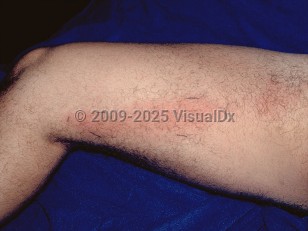Cellulitis in Child
See also in: Cellulitis DDx,Anogenital,Hair and Scalp,Oral Mucosal LesionAlerts and Notices
Important News & Links
Synopsis

Cellulitis is an inflammatory bacterial infection of the dermis and subcutaneous tissues often caused by Group A streptococci (Streptococcus pyogenes) or Staphylococcus aureus. Haemophilus influenzae was formerly a common cause of head and neck cellulitis (including periorbital and orbital cellulitis) in children until routine H influenzae type B (HiB) vaccination was established in developed countries. Other bacterial agents may be considered based on immunization status and age.
In cellulitis, bacteria invade through breaks in the skin, including insect bites, puncture wounds, lesions from dermatitis, varicella, and burns. The clinical manifestations of cellulitis include rapidly progressive areas of skin edema, redness, warmth, and pain with or without associated lymphangitis or lymphadenitis. In children, cellulitis often occurs on the lower extremities and buttocks. Systemic symptoms of fever, malaise, and chills are common. In immunosuppressed individuals, the infection can spread to cause large abscesses, necrosis, and dissemination into blood. Predisposing factors include conditions that compromise the barrier function of the skin (such as atopic dermatitis) or weakened host defenses (such as malnutrition, obesity, trauma, chronic edema, cancer, and HIV infection).
Children with facial cellulitis are more often admitted to the hospital and may require multidisciplinary care, particularly if there is periorbital or orbital cellulitis present.
Recurrent cellulitis occurs less frequently in children as compared to adults; risk factors include lymphedema and rhinosinusitis (for periorbital cellulitis).
See the Infant / Neonate summary for information on cellulitis-adenitis syndrome.
Although many cases of cellulitis are attributable to Streptococcus spp, S aureus is another cause of cellulitis, and it is important to be cognizant of the rising prevalence of methicillin-resistant S aureus (MRSA) in communities. S aureus should be considered for purulent infections. In the outpatient setting, MRSA coverage should be added for patients whose cellulitis has not responded to antistaphylococcal beta-lactam therapy.
In cellulitis, bacteria invade through breaks in the skin, including insect bites, puncture wounds, lesions from dermatitis, varicella, and burns. The clinical manifestations of cellulitis include rapidly progressive areas of skin edema, redness, warmth, and pain with or without associated lymphangitis or lymphadenitis. In children, cellulitis often occurs on the lower extremities and buttocks. Systemic symptoms of fever, malaise, and chills are common. In immunosuppressed individuals, the infection can spread to cause large abscesses, necrosis, and dissemination into blood. Predisposing factors include conditions that compromise the barrier function of the skin (such as atopic dermatitis) or weakened host defenses (such as malnutrition, obesity, trauma, chronic edema, cancer, and HIV infection).
Children with facial cellulitis are more often admitted to the hospital and may require multidisciplinary care, particularly if there is periorbital or orbital cellulitis present.
Recurrent cellulitis occurs less frequently in children as compared to adults; risk factors include lymphedema and rhinosinusitis (for periorbital cellulitis).
See the Infant / Neonate summary for information on cellulitis-adenitis syndrome.
Although many cases of cellulitis are attributable to Streptococcus spp, S aureus is another cause of cellulitis, and it is important to be cognizant of the rising prevalence of methicillin-resistant S aureus (MRSA) in communities. S aureus should be considered for purulent infections. In the outpatient setting, MRSA coverage should be added for patients whose cellulitis has not responded to antistaphylococcal beta-lactam therapy.
Codes
ICD10CM:
L03.90 – Cellulitis, unspecified
SNOMEDCT:
128045006 – Cellulitis
L03.90 – Cellulitis, unspecified
SNOMEDCT:
128045006 – Cellulitis
Look For
Subscription Required
Diagnostic Pearls
Subscription Required
Differential Diagnosis & Pitfalls

To perform a comparison, select diagnoses from the classic differential
Subscription Required
Best Tests
Subscription Required
Management Pearls
Subscription Required
Therapy
Subscription Required
References
Subscription Required
Last Reviewed:03/25/2023
Last Updated:03/30/2023
Last Updated:03/30/2023
 Patient Information for Cellulitis in Child
Patient Information for Cellulitis in Child
Premium Feature
VisualDx Patient Handouts
Available in the Elite package
- Improve treatment compliance
- Reduce after-hours questions
- Increase patient engagement and satisfaction
- Written in clear, easy-to-understand language. No confusing jargon.
- Available in English and Spanish
- Print out or email directly to your patient
Upgrade Today

Cellulitis in Child
See also in: Cellulitis DDx,Anogenital,Hair and Scalp,Oral Mucosal Lesion
